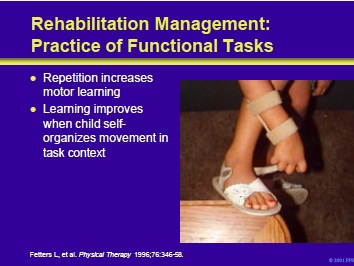
Repetition increases motor learning. Learning improves when child self-organizes movement(s) in the context of various tasks.
Tasks can also be practiced in the context of adaptive equipment. For example, the results of practice in reaching were documented in children with spastic quadriplegia. Patients demonstrated greater changes in movement time post-practice intervention than with neurodevelopmental therapy intervention.
Children in both treatment groups demonstrated reduced movement time and movement units in reaching with both therapy interventions; however, reaction time did not change with either intervention.
Fetters L, Kluzik J. The effects of neurodevelopmental treatment versus practice on the reaching of children with spastic cerebral palsy. Physical Therapy 1996;76:346-58.
Article Index
Page 8 of 15
Add comment